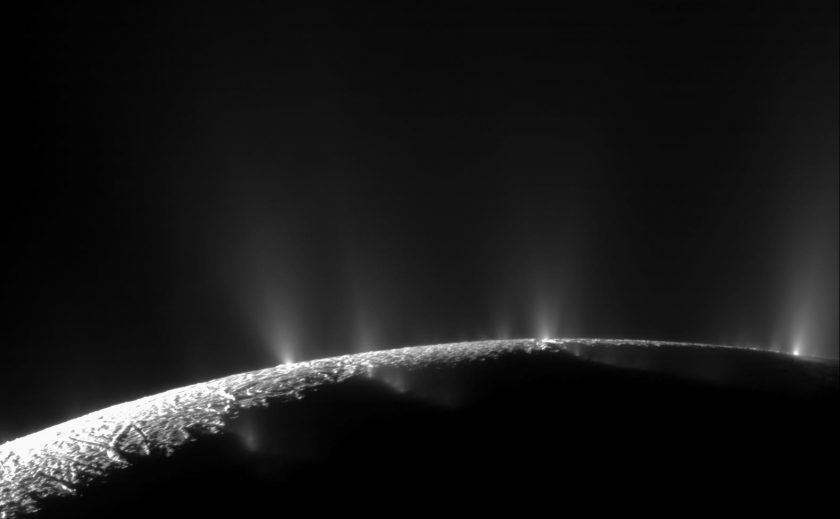Study of Saturn’s Moon Adds to Evidence of Strong Ocean Currents on Enceladus
April 21, 2023

Beneath the frozen surface of Saturn’s icy moon Enceladus lies a vast ocean where, according to a new study, turbulent waters carry nutrients and minerals from hot hydrothermal vents to the icy surface. There, the particles are forced through cracks in the ice and ejected into space within great gassy plumes.
Such particles were detected by NASA’s Cassini spacecraft, but until now scientists had no clear explanation for how material from the seafloor, which is six times deeper than on Earth, ended up in Enceladus’s plumes. Researchers built an analytical model to answer the question, and found that Enceladus has ocean currents strong enough to carry the tiny sand-like particles from the seafloor to its ice shell.
The study’s explanation that the particles are carried by ocean currents driven by a hot, geologically active seafloor is important because scientists believe life on Earth could have first emerged in similarly warm, nutrient-rich waters around hydrothermal vents. The findings will guide future missions to detect life on Enceladus by providing environmental context to interpret any potential biosignatures, said study coauthor Krista Soderlund, a research scientist at the University of Texas Institute for Geophysics.
“It gives additional credence to the possibility of there being conditions suitable for life on Enceladus,” said Soderlund, who specializes in computer modeling of ocean worlds.
The research, which was led by UCLA, was published in the Nature journal, Communications Earth & Environment.
Enceladus’s active geology is fueled by tidal forces as it orbits Saturn. The moon is tugged and squished by gravity, creating friction that heats both the moon’s ice shell and its deep rocky core. When the Cassini spacecraft flew through one of Enceladus’s plumes in 2015 it found substantial amounts of hydrogen gas together with silica particles — compelling evidence for hydrothermal activity at the ocean floor. But the spacecraft’s sensors couldn’t answer how the particles travelled through nearly 40 miles of water and 3 miles of ice.
To solve the puzzle, the study’s lead author Ashley Schoenfeld, a UCLA doctoral student in planetary science, examined results from simple water tank experiments showing how sediment particles move around water. She then constructed a theoretical framework based on fluid dynamics and, together with her collaborators, came up with calculations to scale up her work for Enceladus.
The new model demonstrated that friction from tidal heating in the moon’s rocky core heats the bottom of the ocean enough to drive currents that transport the silica particles toward the surface, where they’re eventually ejected into space. Their calculations showed that where the ice is thinnest, the particles in the plumes could be as little as a few months old.
“The fractures that cut through the ice shell into this subsurface ocean can act as direct conduits for captured materials to be flung into space,” Schoenfeld said. “Enceladus is giving us free samples of what’s hidden deep below.”
On Earth, similar deep-sea hydrothermal vents harbor a multitude of fascinating organisms that feast on minerals the vents release.
To determine whether Enceladus’s vents could support life, scientists would need to test the plumes for biosignatures. That’s something that future spacecraft will be equipped to do. According to Soderlund, the new study offers guidance that should aid the search for those biosignatures.
“Having an understanding of what material is ejected from the plume, how long it’s been in the ocean and where it comes from, are all really important things to understand what you measure coming out of the plume,” she said.
The research was funded by the National Science Foundation and NASA.
Adapted from a press release published by UCLA Newsroom.
